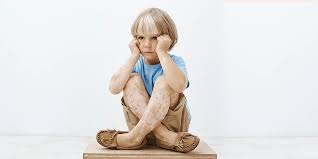How Do White Patches from Vitiligo Affect a Child’s Confidence?

Strong 8k brings an ultra-HD IPTV experience to your living room and your pocket.
Explore how white patches from vitiligo impact a child’s confidence, with insights on treatment options, emotional support, and natural healing oils.
Understanding the Impact of Vitiligo White Patches on a Child’s Confidence
Vitiligo is a long-term skin condition that causes white patches to appear on the skin due to the destruction or malfunction of melanocytes—the cells responsible for producing melanin. These vitiligo white patches are often more noticeable in children with darker skin tones and may affect various areas of the body, including the face, hands, elbows, and knees.
For children, visible skin changes can lead to emotional stress and confusion. As they grow and become more aware of social dynamics, their appearance plays a significant role in self-esteem. When these patches appear at a young age, it can deeply affect how they perceive themselves and how others interact with them.
Emotional and Social Challenges Faced by Children with Vitiligo
Vitiligo in children can trigger emotional upheaval. Kids may feel isolated, anxious, or embarrassed, especially when their peers make comments or ask uncomfortable questions. At school, they might be teased or bullied due to their appearance, which can result in social withdrawal and even academic decline.
The psychological toll of vitiligo often includes:
Low self-esteem
Social anxiety
Avoidance of social interaction
Reluctance to participate in sports or events
Depression in severe cases
Early intervention by parents, educators, and healthcare providers is crucial to ensure these children receive the emotional support they need.
The Role of Family Support in Building Confidence
Support from family members can significantly reduce the negative impact of vitiligo on a child’s mental health. Parents who openly discuss the condition, emphasize their child’s strengths beyond appearance, and advocate for inclusivity can boost their child’s confidence.
Children must be reminded that vitiligo skin disorder is not contagious or dangerous. When caregivers treat the condition as something manageable and normal, children are more likely to accept themselves and feel less different.
Educating Classmates and Teachers
In many cases, the child’s classmates and even teachers are unfamiliar with vitiligo. Educating school communities can foster empathy and understanding, reducing instances of teasing or exclusion.
Some effective ways to raise awareness include:
Classroom presentations or discussions
Informational pamphlets
One-on-one conversations with peers
Teachers modeling inclusive behavior
This helps create a supportive environment, allowing the child to feel accepted and valued regardless of their skin appearance.
Physical Discomfort and Treatment Struggles
Though vitiligo is largely painless, some children may experience itching or discomfort in affected areas. The challenge arises more in treatment plans. Steroid creams, light therapy, or depigmentation treatments can be difficult for children to tolerate or understand.
A more approachable and gentle alternative is vitiligo treatment through natural oils and herbal remedies. These not only reduce the risk of side effects but are also easier to apply as part of daily routines.
Building Self-Image and Resilience
Children dealing with vitiligo benefit immensely from confidence-building activities. These may include:
Joining support groups
Reading stories of others with vitiligo
Roleplaying social scenarios
Encouraging participation in hobbies and sports
Such interventions teach children that their value goes beyond looks, reinforcing a positive self-image. The support of friends, siblings, and mentors also plays a pivotal role in this development.
Natural Remedies as a Holistic Approach
With concerns about long-term medication side effects, many parents turn to Anti Vitiligo Oil for safe, herbal support. Made from essential oils and plant extracts, this oil promotes skin regeneration and pigment restoration without harmful chemicals.
The oil can be massaged gently on affected areas twice a day. Over time, it helps stimulate melanocytes and may gradually restore natural skin color. This method not only improves physical appearance but also encourages children to stick with a non-invasive, comforting treatment.
Long-Term Management of Vitiligo in Children
There is no permanent cure for vitiligo, but proper management can control its spread and appearance. Lifestyle modifications, stress reduction techniques, and healthy diets rich in antioxidants can also help. Combined with vitiligo herbal oil applications, this holistic strategy gives better results.
Children should also be educated about sun safety, as depigmented skin is more prone to sunburn. Using sunscreen or covering exposed areas becomes essential.
The Importance of Positive Representation
When children see people with vitiligo in the media, sports, and entertainment, it can greatly influence how they view themselves. Representation matters. Figures like model Winnie Harlow, who openly embraces her vitiligo, show young people that differences can be beautiful and empowering.
Books, cartoons, and digital content featuring characters with vitiligo help children feel seen and validated. Encouraging them to express themselves through art, storytelling, or journaling about their experiences also aids in emotional growth.
When to Seek Professional Help
If a child shows signs of depression, anxiety, or severe withdrawal due to vitiligo, it’s important to consult a child psychologist. Therapy, especially cognitive-behavioral therapy (CBT), can help children process their emotions and develop resilience.
Support groups for families dealing with vitiligo also provide a space for shared experiences and coping strategies.
FAQs About Vitiligo in Children
1. Can vitiligo be cured in children?
There’s no permanent cure, but treatments like natural oils, topical creams, and phototherapy can manage the condition effectively.
2. Is vitiligo contagious?
No, vitiligo is not contagious. It cannot spread through physical contact or sharing personal items.
3. Can a child with vitiligo go out in the sun?
Yes, but sun protection is necessary. Use sunscreen and cover exposed areas to avoid burns.
4. Does vitiligo cause any other health issues?
Vitiligo is primarily a skin condition. However, in some cases, it may be linked to autoimmune disorders. Regular medical checkups are advised.
5. Is it safe to use natural oils for vitiligo?
Yes, natural oils like Anti Vitiligo Oil are safe and often preferred by parents due to their gentle and herbal formulation.
6. How should I talk to my child about their vitiligo?
Keep the conversation open and age-appropriate. Emphasize that their skin doesn’t define their worth and they’re loved exactly as they are.
Conclusion
White patches caused by vitiligo can have a profound impact on a child’s confidence. However, with emotional support, education, and the right treatment approach—including safe, herbal options like Anti Vitiligo Oil Herbal Treatment—children can lead happy, empowered lives.
The goal is not just to manage skin discoloration but to nurture emotional resilience, build self-esteem, and foster a sense of acceptance. With the right care, children with vitiligo can feel beautiful, strong, and proud of who they are.
https://medium.com/@cureherbals/vitiligo-in-children-causes-symptoms-treatment-and-parent-faqs-955696baa11a
https://sites.google.com/view/vitiligo-in-childrens/home
https://cureherbalsbest.blogspot.com/2025/06/at-what-age-do-children-usually-develop.html
Note: IndiBlogHub features both user-submitted and editorial content. We do not verify third-party contributions. Read our Disclaimer and Privacy Policyfor details.


